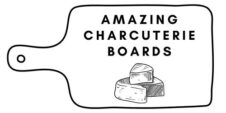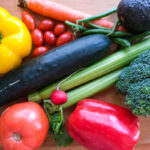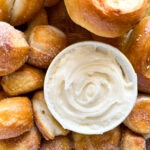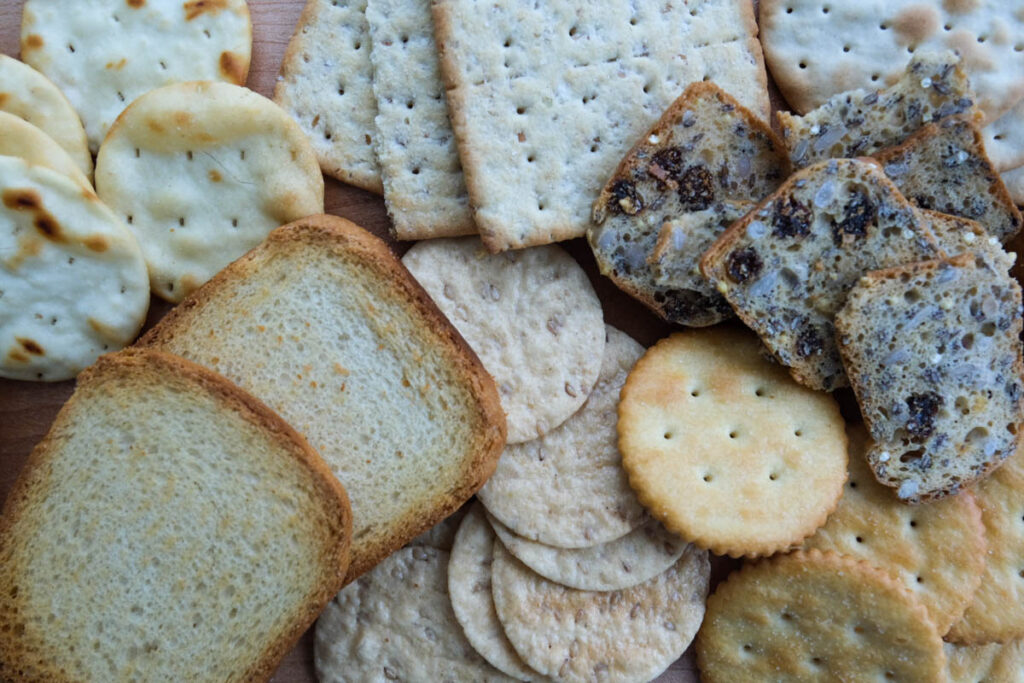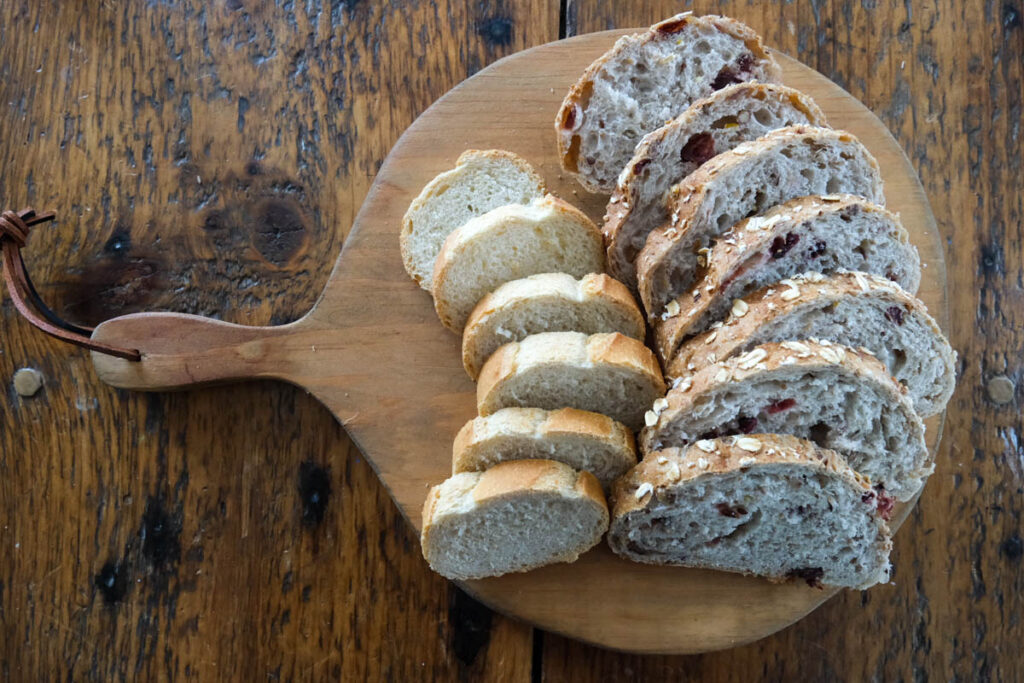Looking to take a good charcuterie board and make it great? Add pickles!
Charcuterie boards are a fun and beautiful addition to your next event, dinner, or brunch. In the last few years, these gorgeous board have explored in popularity.
Pickles are an excellent addition to a charcuterie board. While tradition pickles are made from cucumbers, many different foods come in a pickled form and add a specific texture and salty flavor to other charcuter board ingredients. In this post you will find suggestions for the best pickles for charcuterie board designs including traditional pickles as well as some of the less common pickled vegetables.
You will also find general information on making your own super easy pickles and how to creatively display pickles on your charcuterie board.
Looking for more amazing charcuterie board ingredients? Check out our ingredients page for more.
Contents
Why Serve Charcuterie Pickles
Adding pickles to a charcuterie board is a fantastic idea because they bring a delightful burst of flavors and textures that perfectly complement the cured meats and cheeses. Pickles provide a refreshing tanginess that cuts through the richness of the meats and cheeses, creating a harmonious balance on your palate.
Whether you opt for classic dill pickles, sweet and spicy bread and butter pickles, or pickled vegetables, each pickle variety adds its unique twist to the overall taste experience. Plus, the vibrant colors of pickled vegetables add visual appeal, making your charcuterie board more enticing.
Best Pickles for Charcuterie Board: Classics
In this section you can see the most common, classic pickle charcuterie board options. For most people, the best pickles for charcuterie board deigsns are classic pickles made with cucumbers.
Cornichons
Cornichons are small, crunchy pickles that originate from France. These tiny gherkins are made from pickling baby cucumbers, resulting in a tangy and mildly sour flavor profile. Their unique texture and tartness make them an excellent addition to any charcuterie board. The French origin of cornichons adds a touch of international flair to your board, impressing your guests with a taste of Europe. Their petite size and vinegary kick provide a refreshing contrast to the rich, savory flavors of cured meats and cheeses. Including cornichons on your charcuterie board will not only elevate the taste experience but also infuse it with a touch of sophistication.
Dill Pickles
Dill pickles are a classic and widely popular type of pickles that have been cherished for generations. Originating from Eastern Europe and Russia, dill pickles are characterized by their fresh dill weed, garlic, and brine seasoning. The dill gives them their signature aromatic and herbaceous flavor, while the brine imparts a tangy kick. Dill pickles are an ideal addition to a charcuterie board due to their versatility. They pair harmoniously with various cured meats like salami, prosciutto, and sausages, adding brightness and a delightful crunch to every bite. Their familiarity and crowd-pleasing taste ensure that everyone will find something to enjoy on the board when you include dill pickles.
Bread and Butter Pickles
Originating in the United States, bread and butter pickles are a sweeter and more delicately flavored option compared to other pickles. Made from cucumbers, onions, and a blend of spices, they boast a perfect balance of sweetness and tanginess. Their name hails from the traditional practice of serving them with bread and butter, emphasizing their versatility as a tasty accompaniment. On a charcuterie board, bread and butter pickles add a delightful contrast to the saltiness of cured meats and cheeses. Their mild and sweet nature appeals to a wide range of palates, making them an excellent choice for guests who prefer a milder pickle option.
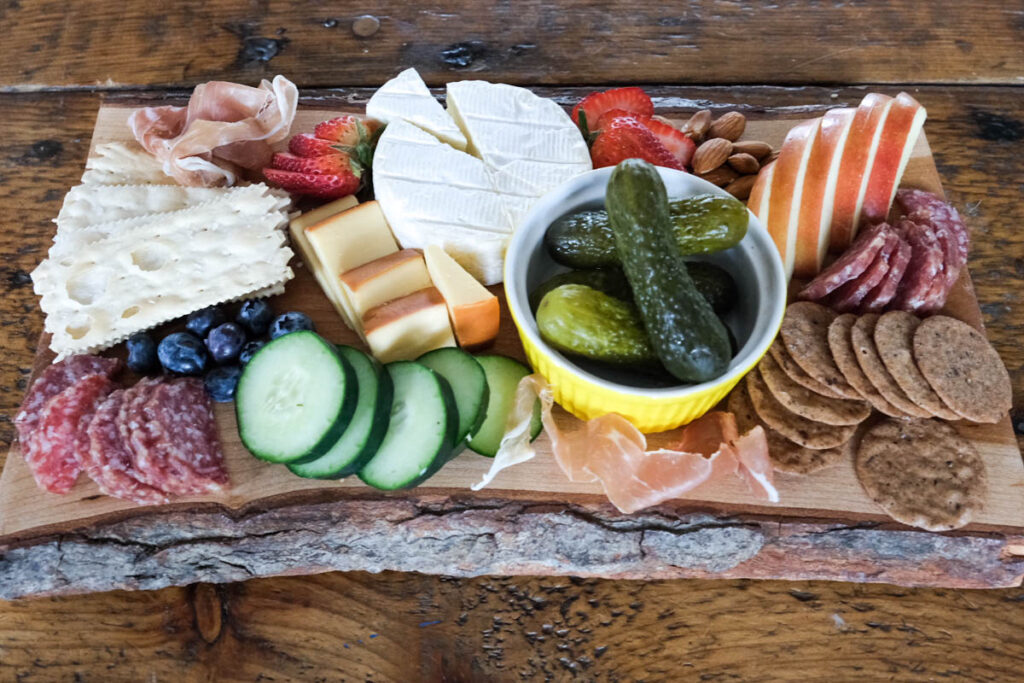
Best Pickles for Charcuterie Board: Other Vegetables
Pickled Onions
Pickled onions are a tangy and colorful addition to a charcuterie board that can add a zesty twist to the overall flavor experience. These pickles are typically made from red onions soaked in a vinegar-based brine, resulting in a vibrant pink hue. Their tartness and slight crunch provide a refreshing balance to the richness of cured meats and cheeses. Pickled onions are a wonderful choice for those looking to add a pop of color and a sharp flavor kick to their charcuterie board. Their versatility also extends to various cuisines, making them an excellent option for pairing with different types of cured meats and cheeses from around the world.
Cipollini Onions
Cipollini onions, originating from Italy, are small, flat-shaped onions with a slightly sweet and mild taste. When pickled, they develop a delightful combination of tanginess and sweetness that sets them apart from other pickles. Adding pickled cipollini onions to your charcuterie board brings a touch of elegance and uniqueness to the table. Their distinctive shape and flavor make them an eye-catching and flavorful addition that pairs exceptionally well with an array of charcuterie options. Whether you’re serving Italian-style cured meats or cheeses from various regions, cipollini onions provide a refined and delicious twist to the overall charcuterie experience.
Pickled Red Onions
Originating from Mexico and commonly found in various cuisines worldwide, pickled red onions are a vibrant and tangy addition to any charcuterie board. Made by soaking thinly sliced red onions in a vinegar-based brine, they develop a beautiful pink color and a zesty flavor. Including pickled red onions on your charcuterie board not only adds a pop of color but also introduces a burst of tanginess that complements the richness of cured meats and cheeses. Their versatility makes them an excellent accompaniment to various charcuterie elements, from delicate prosciutto to robust aged cheeses, creating a delightful balance of flavors and textures.
Pickled Jalapenos
Hailing from Mexico, pickled jalapenos are small green peppers that have been preserved in a brine infused with spices. Known for their spicy kick, they add a tantalizing heat to your charcuterie board. Pairing perfectly with milder meats and cheeses, pickled jalapenos offer a delightful contrast that excites the taste buds. Whether you prefer a subtle hint of heat or a fiery explosion, these pickled peppers provide a customizable level of spiciness, making them a great choice for adding excitement to your charcuterie board.
Pickled Carrots
Pickled carrots, originating from various cuisines worldwide, offer a unique twist to your charcuterie board. These vibrant orange sticks are pickled in a brine seasoned with aromatic spices, resulting in a sweet and tangy flavor profile. Their satisfying crunch and slightly sweet taste make them an excellent choice for pairing with cured meats and cheeses. The pickled carrots’ bright color and refreshing taste elevate the visual appeal and taste experience of your charcuterie board, making them a must-have addition to your spread.
Pickled Beets
Known for their beautiful deep purple hue, pickled beets are a delightful and earthy addition to any charcuterie board. Originally from the Mediterranean region, these tender beet slices are pickled in a tangy brine, transforming their taste into a sweet and slightly tart delight. Including pickled beets on your charcuterie board introduces a touch of sweetness that complements the saltiness of cured meats and cheeses. Their striking color adds an eye-catching element, making your board not only flavorful but visually appealing as well.
Pickled Green Beans
Pickled green beans, also known as dilly beans, are a beloved American pickle with origins in the United States. These crisp and tangy green beans are pickled in a brine infused with dill and other aromatic spices. Adding pickled green beans to your charcuterie board brings a fresh and tangy component to the mix. Their vibrant green color and satisfying crunch create an enjoyable contrast with the cured meats and cheeses, providing a delightful palate cleanser between each bite.
Pickled Asparagus
Pickled asparagus spears offer an elegant and sophisticated addition to your charcuterie board. Originating from various cuisines, these tender asparagus spears are pickled in a flavorful brine. Their tangy and slightly earthy taste makes them a versatile companion for different types of cured meats and cheeses. Including pickled asparagus on your charcuterie board not only introduces a touch of refinement but also enhances the overall taste experience with its unique flavor and texture.
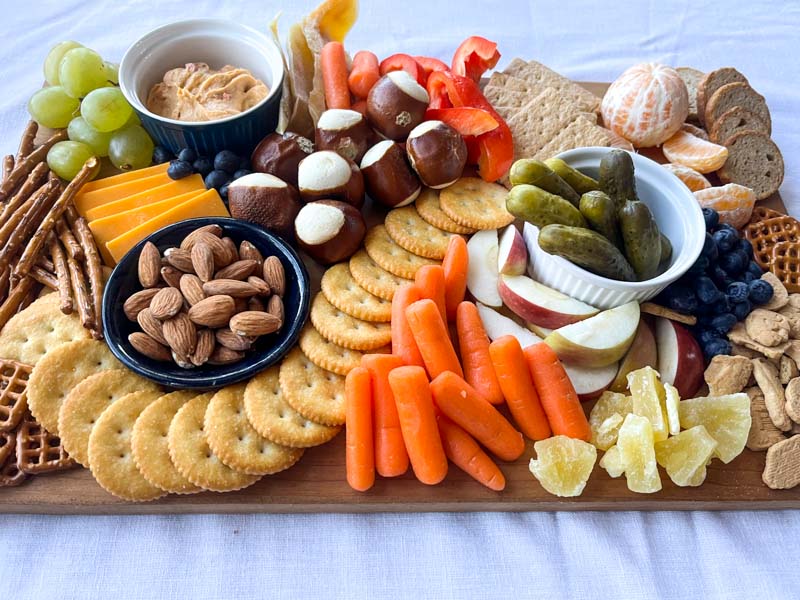
Where to Find Pickles
You have two options when finding pickles for your charcuterie board. You can purchase pickles online, from a shop or a farmers market or you can make your own pickles. Pickles are incredibly easy to make and are also widely available.
If you are looking for specialty pickles for your charcuterie board, start with local markets or spcialty food shops.
One of the easiest places to find charcuterie board pickles is simply search on Amazon as you can find a wide variety.
Making your Own Pickles
Making your own pickles is very easy, especially if you are making friend pickes that will be kept cold. With just some vinegar and some basic herbs and spices you can pickle almost any vegetable you want to use. This also allows you to customize your spice level.
You can find instruction for making your own pickles online – check out the Kitchn for a good overview.
Serving Pickles on a Charcuterie Board
Serving Pickles on a Charcuterie Board
While it is possible to make a pickle charcuterie board, most of the time, pickles are served on a charcuterie board alongside other ingredients. Below you can see recomendations on how to serve charcuterie board pickles. Note that choosing the best pickles for charcuterie board designs depends on the other foods you will be serving.
Pairing Pickles with Cured Meats and Cheeses
When curating the best pickles for your charcuterie board, it’s important to consider complementary flavor profiles. The pickles you choose should enhance the taste of the cured meats and cheeses, creating a harmonious balance of flavors. Opt for pickles with varying levels of tanginess, sweetness, and spiciness to add depth and complexity to the overall taste experience. For instance, the tangy zing of pickled red onions complements the richness of salty prosciutto, while the sweetness of pickled beets pairs beautifully with creamy brie cheese.
Balancing Textures on the Charcuterie Board
In addition to harmonizing flavors, a well-balanced charcuterie board considers the textures of the pickles. Incorporate pickles that offer a range of textures, such as crunchy, crisp, and tender. The satisfying crunch of pickled green beans contrasts wonderfully with the smoothness of soft cheeses, while the tender bite of pickled asparagus complements the chewiness of aged meats. Striking a balance between these textures creates a dynamic and enjoyable eating experience, keeping your guests eagerly exploring the charcuterie board for more delicious combinations.
I find that pickles themselves offer a great variety of tastes.
Highlighting Regional and Cultural Combinations
Pickles from different regions and cultures offer an excellent opportunity to introduce exciting and unique combinations to your charcuterie board. Consider adding pickles with distinct regional influences, like Korean kimchi or Indian mango pickles. These pickles not only infuse the board with new and exciting flavors but also showcase the diverse culinary traditions from around the world. Guests will be delighted to explore these cultural combinations, creating a memorable and educational experience while enjoying their favorite cured meats and cheeses.
Tips for Creative and Appealing Arrangements
Presenting your pickles creatively and appealingly on the charcuterie board can elevate the visual allure of your spread. Arrange the pickles strategically to create a visually pleasing display, making them easily accessible for your guests. You can place them in clusters or weave them throughout the board, enhancing the overall aesthetics.
Utilizing small bowls or ramekins for the pickles not only keeps them contained but also adds a polished touch to the presentation. Consider using pickles as dividers between different sections of the board or garnishing the board with colorful pickled vegetables to add a burst of vibrancy.
Placing Pickles Strategically on the Board: When serving pickles on a charcuterie board, thoughtful placement is key. Arrange the pickles strategically to create a balanced and visually appealing spread. Place them near their complementary cured meats and cheeses to encourage delightful pairings. For example, pair pickled jalapenos with milder cheeses to balance the spiciness, or set pickled carrots beside prosciutto for a refreshing crunch. Placing the pickles strategically ensures that your guests can easily explore different combinations while enjoying the full range of flavors on the board.
Using Ramekins and Small Bowls for a Polished Look: To add a touch of elegance to your charcuterie board, use small bowls or ramekins to serve the pickles. This not only keeps the pickles neatly contained but also prevents them from mixing with other elements on the board. Opt for stylish or decorative containers that complement the overall aesthetic of the spread. Ramekins and bowls also make it convenient for guests to pick up the pickles, enhancing the dining experience and adding a polished touch to your presentation.
Pairing Pickles with Accompaniments like Mustards and Spreads: To take your charcuterie board to the next level, consider pairing the pickles with complementary condiments like mustards, chutneys, or spreads. For instance, serve pickled red onions alongside a tangy Dijon mustard or pair pickled beets with a luscious goat cheese spread. These accompaniments not only enhance the flavors of the pickles but also offer additional options for guests to customize their charcuterie experience. It adds depth and complexity to the board, enticing guests to experiment and savor each unique combination.
Catering to Dietary Preferences and Restrictions: When serving pickles on a charcuterie board, it’s important to consider your guests’ dietary preferences and restrictions. Include a variety of pickles that cater to different dietary needs, such as vegan, gluten-free, or low-sodium options. Offering a diverse selection ensures that all guests can enjoy the charcuterie board without worry. Label the pickles and any accompanying condiments to indicate their ingredients and accommodate guests with allergies or dietary restrictions. Thoughtful consideration for your guests’ needs will make the charcuterie board a welcoming and inclusive experience for everyone.

The Art of Garnishing with Pickles
Decorating the Board with Pickles as Garnish: Garnishing your charcuterie board with pickles adds a finishing touch that enhances both the presentation and taste of the spread. Use pickles as accents to add pops of color and visual appeal. For example, place a few pickled red onions on top of a cheese wheel or add a pickle spear to the center of a charcuterie platter. These simple touches elevate the overall look of the board, making it more inviting and enticing for your guests.
Enhancing Aesthetics with Colorful Pickled Vegetables: Colorful pickled vegetables are not only delicious but also visually appealing. Utilize pickled vegetables like beets, carrots, or green beans to add bright splashes of color to the charcuterie board. Arrange them in a visually pleasing manner, either in clusters or artfully scattered around the board. The vibrant hues of the pickled vegetables create an attractive and appetizing presentation that entices your guests to dive into the delicious spread.
Utilizing Different Shapes and Cuts for Visual Appeal: Experimenting with different shapes and cuts of pickled vegetables can add an artistic flair to your charcuterie board. For instance, pickle vegetables in various shapes, such as spears, slices, or whole pieces. Arrange them in a way that complements the shapes of the cured meats and cheeses. This artistic arrangement adds visual interest and sophistication to the board, impressing your guests and making your charcuterie spread a feast for both the eyes and the taste buds.
By incorporating these tips for serving and garnishing pickles, you can elevate the overall appeal of your charcuterie board, turning it into a stunning and delightful culinary centerpiece. Combining the best pickles for charcuterie board with creative designs will make the perfect board!

Looking for more ingredients for charcuterie Boards?
- Best Bread for Charcuterie Boards
- Best Dried Fruit for Charcuterie Boards
- Best Nuts for Charcuterie Boards
- Best Fruit for Charcuterie Boards
- Best Veggies for Charcuterie Boards

